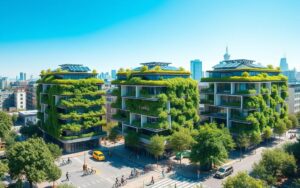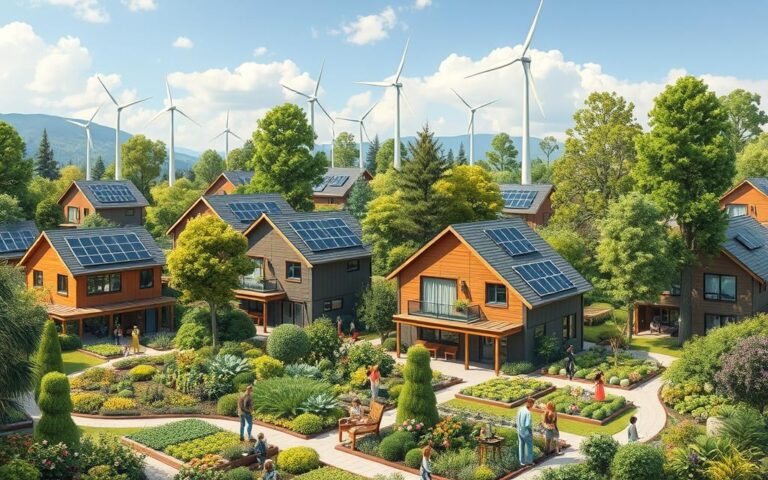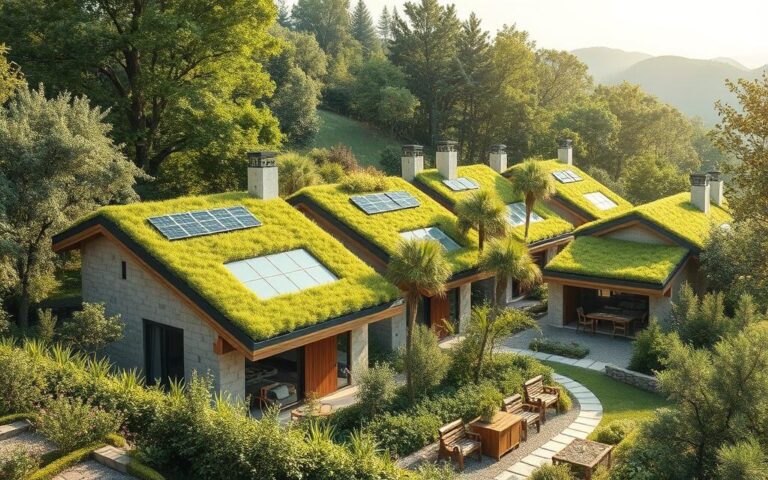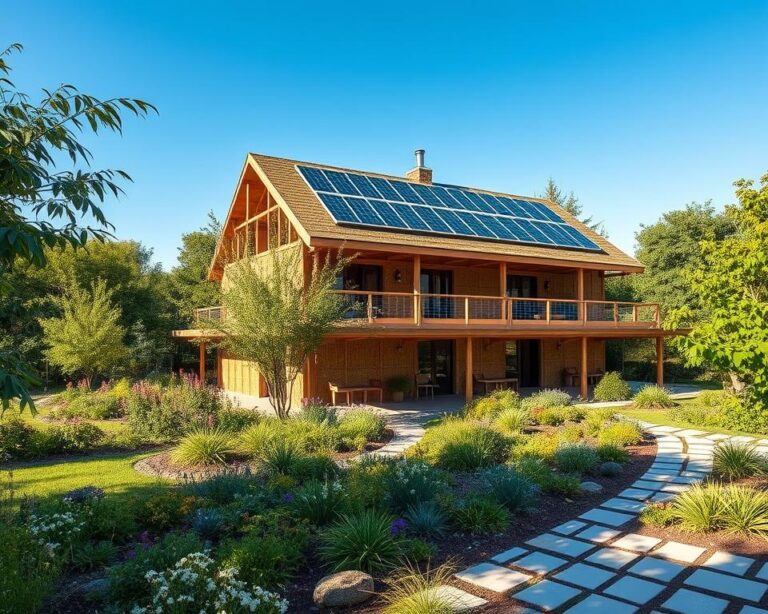Did you know green product standards have grown a lot since the 1980s? Now, there are hundreds of certifications worldwide for sustainable construction. These eco-friendly building codes are key in the fight against climate change. They help architects, builders, and developers make buildings that use less energy and harm the environment less.
Green Building Standards are important for making buildings that are good for the planet and people. As more places adopt these standards, knowing about them is crucial. It helps everyone make choices that are better for the environment and their projects.

What Are Green Building Standards?
Green building standards are guidelines for architects and contractors. They aim to create structures that are good for the environment. These standards help use resources wisely, cut down on harmful emissions, and encourage eco-friendly building codes.
Definition and Overview
Green building standards are rules for building in an eco-friendly way. They help achieve sustainable construction by focusing on energy use, air quality, and site selection. Following these standards can greatly reduce environmental harm.
Importance in Construction
Green building standards are more important than ever as people want eco-friendly construction. These rules guide builders to use sustainable practices and follow eco-friendly codes. They help make buildings more energy-efficient and meet environmental laws.
Key Terminologies to Know
Knowing key terms is crucial for understanding green building standards. Important terms include:
- Energy Efficiency: Reducing energy use without losing comfort or performance.
- Sustainable Materials: Resources used in a way that’s good for the environment.
- Indoor Environmental Quality: How well a building’s air and light affect its occupants.
Major Green Building Certification Programs
Green building certification programs help make construction and operation more sustainable. LEED, BREEAM, and Energy Star are well-known. They check how well buildings use energy and are green.
LEED Certification
LEED, or Leadership in Energy and Environmental Design, is from the U.S. Green Building Council. It’s for all kinds of buildings. It looks at energy use, site development, and water saving.
LEED gives out levels from Certified to Platinum. This depends on how well a building meets its energy-efficient design criteria. By 2019, LEED had 80,000 registered projects and 32,500 certified ones. This shows it’s a big deal for green building.
Energy Star
Energy Star is run by the U.S. Environmental Protection Agency. It’s all about saving energy in buildings. Buildings must use less energy than set benchmarks to get certified.
Energy Star helps cut down energy costs and environmental harm. It focuses on energy-efficient design criteria.
BREEAM
BREEAM, or Building Research Establishment’s Environmental Assessment Method, started in the UK. It checks many things like waste, ecology, and energy. Since 1990, it’s certified over 560,000 projects in more than 50 countries.
BREEAM gives levels from Pass to Outstanding. This depends on how well a project meets its benchmarks. It encourages big steps towards being green and responsible.
Benefits of Meeting Green Building Standards
Meeting green building standards has many benefits. These benefits help the environment, save money, and improve health and well-being.
Environmental Impact
Using sustainable construction practices is key to reducing a building’s environmental impact. Buildings are a big source of global energy-related CO2 emissions, making up almost 40 percent. Green buildings cut down on waste, save water, and lower greenhouse gas emissions.
By 2030, green buildings aim to divert over 540 million tons of waste from landfills. They also plan to decrease CO2 emissions by 34 percent.
Economic Advantages
Green building practices offer economic benefits. Green building retrofits can cut operation costs by nearly 10 percent in just one year. Studies show that LEED-certified properties see a 10 percent or greater increase in value.
These properties also attract better tenants. Tenants are willing to pay more for LEED certified space, showing its value.
Improved Health and Well-being
Green buildings focus on the health and comfort of those inside. LEED-certified buildings ensure good indoor air quality and use low-VOC materials. This creates healthier environments.
Access to natural light and views of nature in these buildings boosts productivity and satisfaction. Research shows green buildings improve health and reduce absenteeism rates.
How to Choose the Right Certification
Choosing the right green building certification is a strategic decision. It’s important to consider several factors. This ensures the certification meets the building’s needs and sustainability goals.
Assessing Your Building’s Needs
Before choosing a certification, evaluate your building’s unique features. Know its size, usage, and current green features. This helps pick a certification that offers the best benefits for your building.
Look into:
- Current energy consumption and efficiency
- Water usage and resource management
- Indoor environmental quality for occupant health
Understanding Different Standards
It’s key to know about different green building standards. Each, like LEED, BREEAM, and Energy Star, has its own goals and criteria. For example:
| Certification Program | Levels of Certification | Key Focus Areas |
|---|---|---|
| LEED | Certified, Silver, Gold, Platinum | Energy, water, materials, indoor environmental quality |
| BREEAM | Pass, Good, Very Good, Excellent, Outstanding | Environmental impact in ten categories |
| Energy Star | 75+ score required | Energy efficiency benchmarks |
| NABERS | 1 to 6 stars | Environmental performance across various metrics |
Cost Considerations
Cost considerations are crucial when choosing a certification. Think about registration fees, consulting costs, and upgrades needed. Knowing these costs helps plan your budget and avoid surprises.
- Initial registration and application fees
- Consultant fees for experts in green building standards
- Expenses related to necessary renovations or upgrades
Steps to Achieve Green Building Certification
Getting green building certification is a detailed process. It ensures a building meets strict environmental standards. Each step is important and helps make the project more sustainable. Using the right strategies at each step is key to getting certified.
Initial Assessment
The first step is a thorough initial assessment. It finds areas for better energy use and waste reduction. This step is crucial for planning improvements and meeting certification standards.
Planning and Design
The planning and design phase is very important. It’s where sustainable materials and energy systems are added. This phase greatly affects the building’s performance. Paying close attention here boosts the chances of meeting certification goals.
Documentation and Submission
Documentation and submission are critical for certification. They make sure the project follows the chosen standards. Each standard has its own rules, like technical drawings and energy data. Managing this well is essential for success.
Common Misconceptions About Green Building Certifications
It’s important to clear up wrong ideas about green building certifications. Many think they cost too much and are hard to get. But, they offer big benefits in the long run. Knowing the truth can help investors and developers see the value of green certifications.
Cost vs. Value
Many believe green building costs too much. But, facts show green buildings get 11% higher rents and 4% more people living there. They also save 20% on maintenance and 10% on running costs in the first year.
New green buildings pay back in about seven years. Retrofits take about six years. This shows green building is a smart choice.
Complexity of Standards
Some think green building rules are too hard to follow. This stops some from going green. But, many groups help make it easier to follow these rules.
Green building can even help with other rules. This lets businesses stay ahead and avoid fines.
Long-Term Benefits
Some doubt green certifications last and are worth it. But, going green is now key in today’s market. The U.S. wants to cut greenhouse gas by 50% by 2030.
Green buildings help meet this goal and stay ahead of future rules. Investors are now looking for green properties. They see these buildings as more valuable and better performing.
The Role of Technology in Green Building
As people become more aware of environmental issues, technology in green building plays a key role. It helps create buildings that are both efficient and eco-friendly. These buildings not only reduce environmental harm but also improve the lives of those who live in them.
Smart Building Solutions
Smart building solutions are changing the game for better management and efficiency. They use smart sensors and automated systems for real-time energy monitoring. This ensures energy is used just right.
These smart solutions also offer powerful analytics. They help building managers make smart choices about energy use. This leads to less waste and lower costs. Plus, smart home tech lets people control things like lights and heat, encouraging a greener lifestyle.
Renewable Energy Integration
Using renewable energy is now crucial in green building. Solar panels and wind turbines are key examples. They help buildings use less fossil fuel.
Buildings that focus on renewable energy get better efficiency ratings. They also aim for green certifications, making them great investments for a sustainable future.
Future Trends in Green Building Standards
The green building world is changing fast. This is thanks to new rules and a big push for sustainability. As we learn more about the environment, building standards are getting better to meet these needs.
Evolving Regulations
Green building rules are getting stricter. Governments are working hard to solve environmental problems. In the U.S., the General Services Administration wants all buildings to be net zero by 2030.
Places like New York City and Boston are also setting high standards. They want buildings to be more sustainable. This shows how fast things are changing.
Emphasis on Sustainability
Sustainability is becoming more important in green building. LEED v5 has new rules to help buildings be greener. It also has a net zero module to guide buildings towards zero energy use.
WELL and Fitwel certifications are also growing. They focus on making buildings better for people. This includes clean air and green spaces. It makes buildings more appealing and meets people’s desire for sustainability.
Community-Based Standards
Now, we’re seeing standards that look at the bigger picture. They consider how buildings affect the whole community. BRE’s BREEAM is a good example. It looks at sustainability and fairness in communities.
This shows a big change. It’s not just about being green. It’s about making buildings better for everyone’s health and happiness.

| Trend | Description | Impact on Industry |
|---|---|---|
| Evolving Regulations | Stricter guidelines set by governmental bodies | Increased compliance efforts required from builders |
| Emphasis on Sustainability | Focus on sustainable materials and health for occupants | More demand for certifications like LEED and BREEAM |
| Community-Based Standards | Standards that consider urban impact and community health | Encourages integrated approaches to development |
Getting Started with Your Green Building Journey
Starting your green building journey needs careful planning. It involves using the right resources and getting expert advice. The U.S. Green Building Council offers tools and frameworks to help you understand green standards.
These resources make it easier to follow the steps for certification. They help you adopt environmentally friendly practices.
Resources and Tools
Using toolkits and guidelines is key when starting with green building. For example, the UW Green Building Standard was updated in July 2024. It has four project tiers for different construction types.
Each tier has specific targets, like water efficiency and energy usage. All new constructions must reach Gold LEED certification or its equivalent. This ensures a path to sustainability.
Finding Expert Guidance
Working with green building experts can make your project better. They offer advice and support during the certification process. They help with complex standards and best practices.
Project managers also get help through technical FAQs. This makes talking about sustainability easier. Experts help with Life Cycle Cost Analysis (LCCA), which evaluates the cost-effectiveness of materials and systems.
Commitment to Sustainability
Committing to sustainability is important from planning to operation. This commitment must be shared by all stakeholders. It’s key to achieving environmental benefits in green buildings.
Standards ban fossil fuel systems in new buildings. They focus on reducing carbon emissions and adding health and wellness features. This makes green building a collective effort. It shows that being green can also be profitable.
FAQ
What are Green Building Standards?
Green Building Standards are guidelines for architects, builders, and developers. They aim to make buildings better for the environment. This is done by using resources wisely and cutting down on emissions.
Why are Green Building Standards important in construction?
These standards are key because they encourage sustainable building. They make buildings more energy-efficient and follow environmental rules. They help professionals meet eco-friendly building codes and get certifications.
What is LEED certification?
LEED (Leadership in Energy and Environmental Design) is a certification by the U.S. Green Building Council. It evaluates buildings in areas like energy use and sustainable site development. Buildings get points for different levels of certification based on their performance.
How does the Energy Star certification work?
The U.S. Environmental Protection Agency manages Energy Star certification. It focuses on energy use in buildings. Buildings that meet or exceed energy use benchmarks get certified. This helps lower energy costs.
What are the benefits of Green Building Standards for the environment?
Green Building Standards help the environment a lot. They reduce waste, save water, and cut down on greenhouse gas emissions. This is true for all stages of a building’s life.
How can I assess my building’s needs for certification?
First, understand what your building needs. Look at its specific requirements and features. This helps choose the right green building certification for your building.
What costs should I consider when pursuing a green building certification?
Think about registration costs, consulting fees, and upgrades needed. Each project’s budget is different, based on its unique needs.
Are there misconceptions about the cost of green building certifications?
Yes, many think green certifications are too expensive. But, they can save money in the long run. They lead to lower operational costs, making them valuable over time.
What role does technology play in green building practices?
Technology helps make buildings smarter and more efficient. Smart sensors and systems adjust conditions in real-time. This improves energy use and reduces waste.
What is the significance of community-based standards in green building?
Community-based standards are becoming more important. They consider the impact on a larger community. They promote sustainable urban development, focusing on ecological and social aspects.




